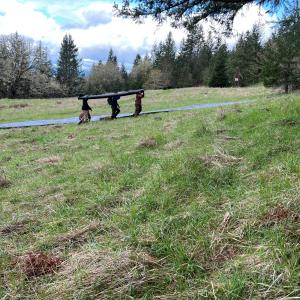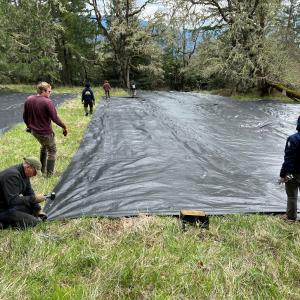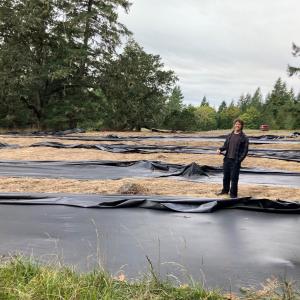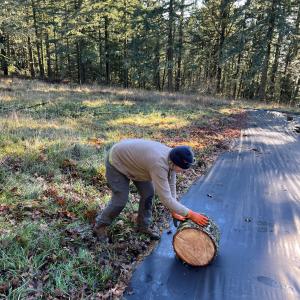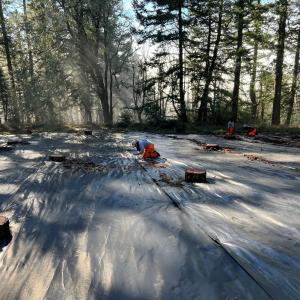By Aynesley Wilson, April 2024
It’s been an uphill battle implementing the solarization project in Meadow D at Oak Basin. Part of an upland meadow complex managed by the Northwest Oregon BLM (Bureau of Land Management) District’s Upper Willamette Field Office in the hills just east of Brownsville, Oregon, Oak Basin has all the challenges that come with a hillside location: exposed, windy, rocky, thin soils, and difficult to access. It is home to small populations of the threatened species Fender’s blue butterfly (Icaricia icarioides fenderi) and Kincaid’s lupine (Lupinus oreganus), as well as Hitchcock’s blue-eyed grass (Sisyrinchium hitchcockii) a Species of Concern. The proliferation of non-native vegetation present in Meadow D was not providing quality habitat for any of these species and the size of the meadow is small at just one and a half acres so the situation seemed to provide the perfect opportunity to try a different approach to weed suppression. Instead of creating a chemical fallow with herbicides, IAE implemented a different process to control the grasses and other invasive species. Half of the meadow was covered in black, woven landscape fabric (the other half will be covered later). This process, called ‘occultation,’ heats the soil underneath and lets water through, which allows the seeds to germinate. However, it blocks light, preventing the seedlings from growing. This differs slightly from regular solarization, which uses clear plastic to super-heat the plants in the summer, effectively scorching them.
In spring of 2023, IAE contracted with Walama Restoration Project (Walama) to install .75 acre of the occultation fabric using 10-inch galvanized nails to secure 5,400 square-foot rolls of geotextile fabric to the uneven ground of Meadow D. The material stayed firmly in place for the entire first summer. However, with the high winds and driving rain of fall storms, some of the fabric and nails were lifted free of the ground and blown into twisted heaps throughout the meadow. Walama returned to the site to troubleshoot and reinstall the fabric. With help from our Fall 2023 AmeriCorps NCCC (National Civilian Community Corps) team, IAE also reinforced the sheeting with tree rounds cut from trees felled around the meadow edge to help weight the fabric down. On following visits to the site throughout the winter months, IAE staff encountered the same issues of the fabric being torn away from the ground by strong winds. However, our repair processes improved with each successive visit. After several repairs we augmented the galvanized nails by adding 10-inch landscape staples and a several dozen more tree rounds. Landscape staples are constructed in a large rectangular U-shape, having 2 points of contact with the soil and greater surface area contact with the fabric. This approach exhibited greater success than previous attempts.
There have certainly been a few important takeaways and lessons learned throughout this process. In assessing a site for solarization/occultation it is beneficial to note the direction in which winds will most likely blow. Knowing this can inform the pattern or order that the fabric sheets are rolled out. The sections should overlap in a way that winds cannot penetrate and lift the leading edges. The outside edges facing oncoming winds should also be weighed down in some way (tree rounds, blocks, etc.). Landscape staples seem to be a better choice than nails and should be used liberally along every edge and as close as a foot apart. Speaking of edges, they should be folded over to provide more grip for the staples so that the fabric does not rip. Even when taking all these techniques into consideration the challenges presented by thin, rocky soils are formidable. In the case of Meadow D at Oak Basin only vigilance and persistence are proven to be the best tools in battling the forces of mother nature. Thank you to our partners at the BLM-UWFO for supporting this project and the species that depend on it for their recovery and to our Fall 2023 AmeriCorps NCCC team helping us out with the heavy lifting.
